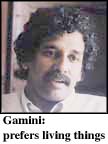
13th February 2000
Front Page|
News/Comment|
Editorial/Opinion| Business|
Sports|
Sports Plus| Mirror Magazine

![]()
Brutal stuff
Keeping 'Raja', the Maligawa tusker 'forever' was his great achievement but Sri Lanka's only practising taxidermist, Gamini Witharana is not enamoured with his unusual profession
By Udena R. Attygalle
 "Taxidermy
is a lie made to look real." That's the truth according to Sri Lanka's
only practising taxidermist, Udaya Gamini Sarath Kumara Nambukara Witharana,
(40), or 'Alphabet Witharana' as he is known to his erstwhile buddies at
school.
"Taxidermy
is a lie made to look real." That's the truth according to Sri Lanka's
only practising taxidermist, Udaya Gamini Sarath Kumara Nambukara Witharana,
(40), or 'Alphabet Witharana' as he is known to his erstwhile buddies at
school.
Moving past the impressive facade of the National Museum, skirting the giant, rusting remains of an old ship's propeller and the remnants of a couple of old American jeeps, we come to a series of old buildings that house the museum staff. We head towards the one with a small board saying "Taxidermy Laboratory", to find our man.
Surrounded by skulls, skeletons and specimens, Gamini is reading voraciously. Born in Gonapura, Galle, he was an early disciple of the old adage 'believe in heroes'. By the time he was 21, he had read all of Dale Carnegie's books on the power of self-will.
The son of a hunter, young Gamini would experiment with his father's 12-bore gun when he was not around. He learnt to shoot and hunt on his own. But then came a sudden change of heart and he began to appreciate the living rather than the dead.
At school, St. Aloysius, he was deputy head prefect and founded an association called "The School Bus Travellers' Association" which looked after their interests. He then worked as a management trainee, but this was not satisfying enough. After two years he sat an exam conducted by the National Museum Department and started work as the assistant taxidermist.
Strangely, he doesn't even like taxidermy any more. He reiterates, "No dead animal is as good as a live one."
His greatest achievement is the work he did together with Palitha Sammerapperuma, the conservator of the museum on the body of Raja, the famous Maligawa tusker. This has made it into the Guinness Book of Records as the first such work on an Asian elephant ever.
Amazingly in a dream Gamini had seen an elephant which he believed was a sign indicating the work ahead of him. The team under the supervision of the then Director of the National Museums Department Thelma Gunarwardena began their work with a prayer. Gamini received the presidential award "Sri Lanka Sikamani" in 1990 for his contribution towards conserving the great Raja.
As for the science of taxidermy, surprisingly it is not dead animals or ones accidentally killed that adorn the museum's taxidermy exhibit. On the contrary, the specimens required are identified and then hunting parties arranged to procure them. No wonder Gamini describes taxidermy as 'brutal'.
The dead animals are first measured and then skinned. Later chemicals are added to the skin, which is then tanned. Only the skull is used in the final product, the rest of the skeleton being thrown away. A "brain spoon" is sometimes used to remove brain cells.
The whole structure is constructed using a combination of plaster of Paris, coir and metal. The skin is treated again and then plastered over the structure, a process that has to be done quickly before it hardens up again.
And they don't waste any specimens either. All are made use of. The best example being a water buffalo exhibit which had been shot in the legs: the ingenious taxidermists had exhibited the animal half submerged in mud to hide its missing legs.
"As there are no osteologists (those who study the structure of a skeleton) in the country, it is the taxidermist who has to play both roles," says Gamini. Ironically while the latter throws away the skeleton, the former constructs a skeletal replica using it.
Gamini has also had the rare opportunity of working with Cetalogist Dr. Stephen Leatherwood of Hubbs-Sea- world Research Institute. Spending days on end in search of whales was all part of life then. He has also been awarded honorary membership of the 'Bat Conservation International' for his work on the distribution and behaviour patterns of wet zone bats.
But that was all in the past. These days Gamini travels daily from Galle to Colombo during the week. "During the weekend I am a Mudalali." He has his own bookshop in Galle: "Lahiru bookshop," he smiles.
During our conversation we digress often to topics like astral bodies, the tomb of Tutankhamen, life after death and so on. The interests of this man are many and varied. His theory is simple; learn from the past and apply it to the present. "I even did research on my family tree," he says.
He is also a writer, visibly proud of the books he has in print. "Sundara Sinharaja" is the first Sinhala book on Sinharaja. "Michael Crichton believes nature cannot be controlled by man. I am of the same view so I identify with his writing," he says.
Gamini is the fourth taxidermist in Sri Lanka, the previous ones being an Englishman named Hart, H.F Fernando (who put together the first and only blue whale specimen in the country ) and K.L.E Perera, Gamini's teacher. Gamini also gratefully remembers the help he received from former directors of the National Museum of Colombo P.H.D.H De Silva and Thelma Gunawardena.








![]()
Front Page| News/Comment| Editorial/Opinion| Plus| Business| Sports| Sports Plus| Mirror Magazine
Please send your comments and suggestions on this web site to

